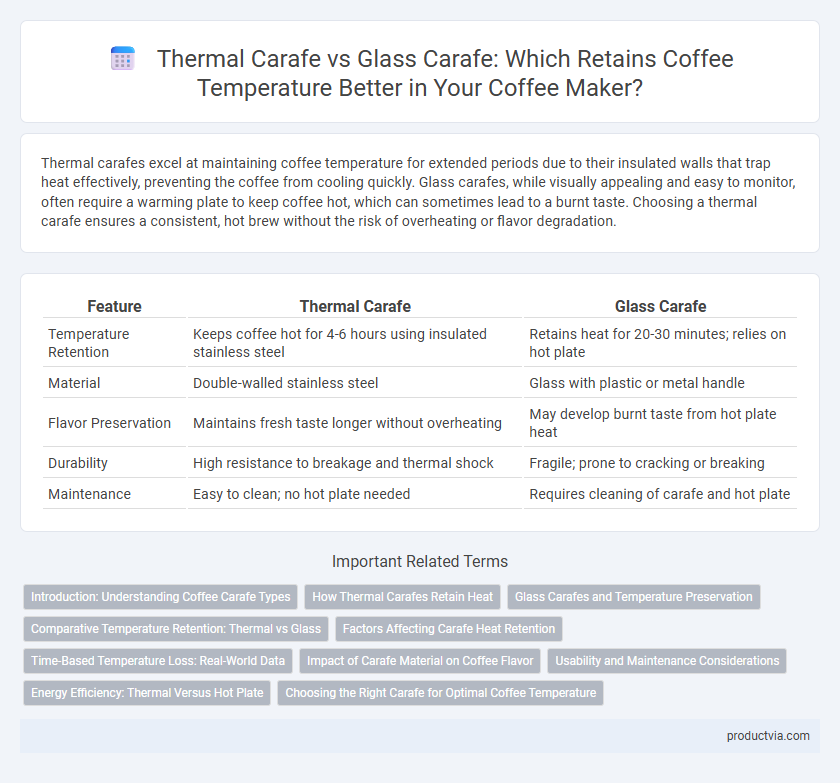Thermal carafes excel at maintaining coffee temperature for extended periods due to their insulated walls that trap heat effectively, preventing the coffee from cooling quickly. Glass carafes, while visually appealing and easy to monitor, often require a warming plate to keep coffee hot, which can sometimes lead to a burnt taste. Choosing a thermal carafe ensures a consistent, hot brew without the risk of overheating or flavor degradation.
Table of Comparison
| Feature | Thermal Carafe | Glass Carafe |
|---|---|---|
| Temperature Retention | Keeps coffee hot for 4-6 hours using insulated stainless steel | Retains heat for 20-30 minutes; relies on hot plate |
| Material | Double-walled stainless steel | Glass with plastic or metal handle |
| Flavor Preservation | Maintains fresh taste longer without overheating | May develop burnt taste from hot plate heat |
| Durability | High resistance to breakage and thermal shock | Fragile; prone to cracking or breaking |
| Maintenance | Easy to clean; no hot plate needed | Requires cleaning of carafe and hot plate |
Introduction: Understanding Coffee Carafe Types
Thermal carafes offer superior coffee temperature retention by utilizing insulated stainless steel walls that minimize heat loss for hours. Glass carafes, typically paired with warming plates, gradually lose heat, which can lead to a burnt or bitter taste over time. Choosing between thermal and glass carafes depends on the desired balance between temperature preservation and brew freshness.
How Thermal Carafes Retain Heat
Thermal carafes retain heat using double-walled stainless steel insulation that traps heat between the layers, preventing heat loss by conduction and convection. This design effectively maintains coffee temperature for several hours without the need for an external heat source. Unlike glass carafes, which rely on warming plates that can overcook coffee, thermal carafes preserve the brew's flavor by providing consistent, gentle heat retention.
Glass Carafes and Temperature Preservation
Glass carafes often include a heat plate to maintain coffee temperature but generally lose heat faster than thermal carafes due to their material properties. While glass carafes provide visual appeal and allow monitoring of coffee levels, their temperature retention is limited, typically lasting 20 to 30 minutes before coffee begins to cool noticeably. Choosing glass carafes suits environments prioritizing aesthetics over long-term heat preservation, as thermal carafes better retain heat for several hours through insulated stainless steel construction.
Comparative Temperature Retention: Thermal vs Glass
Thermal carafes excel at temperature retention by using insulated walls that keep coffee hot for several hours without a heating element, maintaining optimal flavor and preventing overcooking. Glass carafes, commonly paired with warming plates, gradually lose heat and risk coffee bitterness due to prolonged exposure to direct heat. Choosing thermal over glass carafes offers superior temperature stability, ensuring a hotter and fresher cup throughout the day.
Factors Affecting Carafe Heat Retention
Thermal carafes excel in heat retention due to their double-walled, vacuum-insulated stainless steel construction, which minimizes heat loss and maintains coffee temperature for several hours. Glass carafes, while visually appealing, lose heat more quickly because of their single-wall design and lack of insulation, often requiring external warming plates that can alter flavor profiles. Factors affecting carafe heat retention include material insulation properties, lid fit and seal quality, and the initial coffee temperature when poured.
Time-Based Temperature Loss: Real-World Data
Thermal carafes maintain coffee temperature significantly longer than glass carafes, with studies showing a temperature loss of only 5-10degF over two hours compared to 20-30degF in glass models. The double-wall insulation in thermal carafes minimizes heat escape, ensuring coffee stays hot for extended periods without a warming plate. Real-world data indicates that users benefit from fresher tasting coffee and energy savings with thermal carafes due to improved temperature retention.
Impact of Carafe Material on Coffee Flavor
Thermal carafes, typically made with insulated stainless steel, excel at maintaining coffee temperature for extended periods without reheating, preserving the original brewed flavor more effectively than glass carafes. Glass carafes offer visual appeal and ease of monitoring coffee levels but often result in faster heat loss, leading to potential flavor degradation due to repeated reheating on warming plates. The choice of carafe material directly influences the balance between temperature retention and flavor preservation, with thermal models preventing the burnt taste caused by excessive heating.
Usability and Maintenance Considerations
Thermal carafes offer superior coffee temperature retention due to their insulated stainless steel design, making them ideal for prolonged use without reheating. Glass carafes provide better visibility to monitor brewing progress but require more frequent cleaning to prevent stains and preserve taste quality. Maintenance for thermal carafes is simpler due to their durable, easy-to-clean surfaces, whereas glass carafes demand careful handling to avoid breakage and may accumulate mineral deposits if not regularly descaled.
Energy Efficiency: Thermal Versus Hot Plate
Thermal carafes excel in energy efficiency by maintaining coffee temperature through insulation, eliminating the need for a heat source and preventing overheating or burnt flavors. Glass carafes rely on hot plates that consume continuous electricity to keep coffee warm, often resulting in temperature fluctuations and increased energy use. Choosing a thermal carafe reduces electricity consumption and preserves coffee flavor consistency by avoiding prolonged heating.
Choosing the Right Carafe for Optimal Coffee Temperature
Thermal carafes excel in maintaining coffee temperature due to their insulated stainless steel construction, which significantly reduces heat loss compared to glass carafes. Glass carafes, while visually appealing and compatible with most drip coffee makers, tend to cool coffee faster since they lack insulation and rely on hot plates that can alter flavor over time. Choosing a thermal carafe ensures longer-lasting heat retention without the risk of burnt taste, optimizing coffee temperature for extended enjoyment.
Thermal carafe vs Glass carafe for coffee temperature retention Infographic

 productvia.com
productvia.com